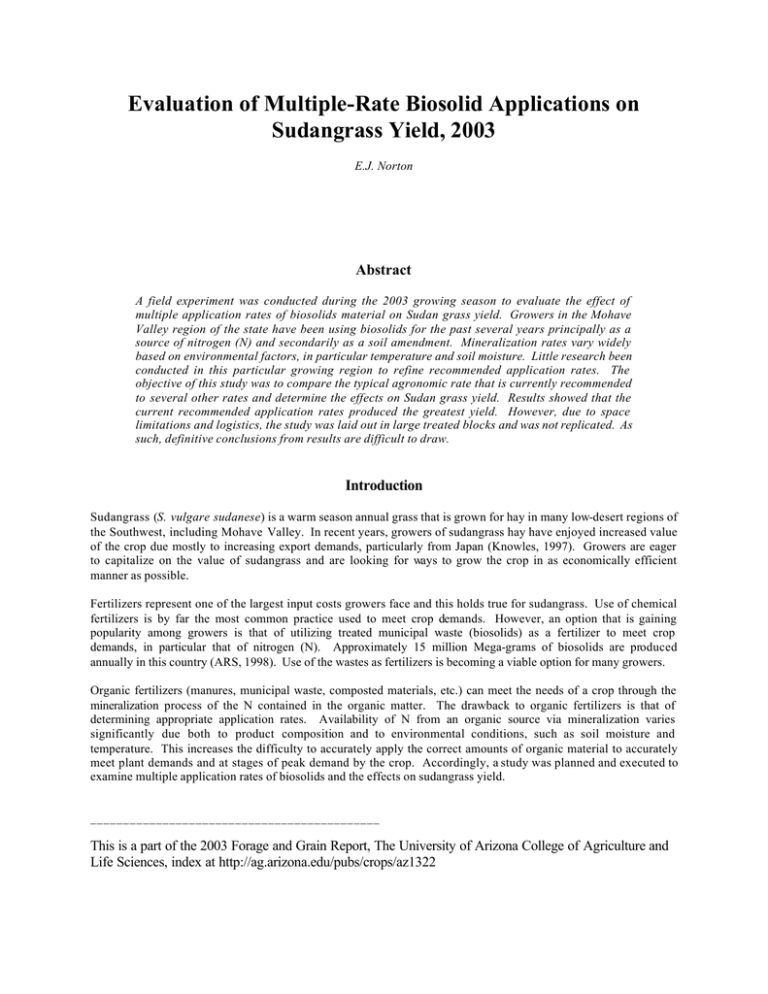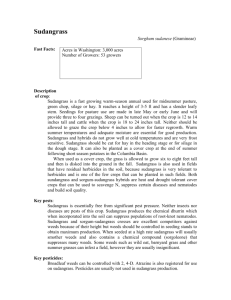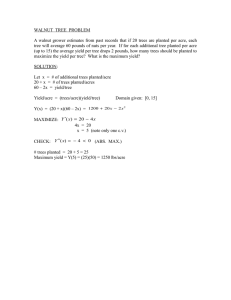Evaluation of Multiple-Rate Biosolid Applications on Sudangrass Yield, 2003
advertisement

Evaluation of Multiple-Rate Biosolid Applications on Sudangrass Yield, 2003 E.J. Norton Abstract A field experiment was conducted during the 2003 growing season to evaluate the effect of multiple application rates of biosolids material on Sudan grass yield. Growers in the Mohave Valley region of the state have been using biosolids for the past several years principally as a source of nitrogen (N) and secondarily as a soil amendment. Mineralization rates vary widely based on environmental factors, in particular temperature and soil moisture. Little research been conducted in this particular growing region to refine recommended application rates. The objective of this study was to compare the typical agronomic rate that is currently recommended to several other rates and determine the effects on Sudan grass yield. Results showed that the current recommended application rates produced the greatest yield. However, due to space limitations and logistics, the study was laid out in large treated blocks and was not replicated. As such, definitive conclusions from results are difficult to draw. Introduction Sudangrass (S. vulgare sudanese) is a warm season annual grass that is grown for hay in many low-desert regions of the Southwest, including Mohave Valley. In recent years, growers of sudangrass hay have enjoyed increased value of the crop due mostly to increasing export demands, particularly from Japan (Knowles, 1997). Growers are eager to capitalize on the value of sudangrass and are looking for ways to grow the crop in as economically efficient manner as possible. Fertilizers represent one of the largest input costs growers face and this holds true for sudangrass. Use of chemical fertilizers is by far the most common practice used to meet crop demands. However, an option that is gaining popularity among growers is that of utilizing treated municipal waste (biosolids) as a fertilizer to meet crop demands, in particular that of nitrogen (N). Approximately 15 million Mega-grams of biosolids are produced annually in this country (ARS, 1998). Use of the wastes as fertilizers is becoming a viable option for many growers. Organic fertilizers (manures, municipal waste, composted materials, etc.) can meet the needs of a crop through the mineralization process of the N contained in the organic matter. The drawback to organic fertilizers is that of determining appropriate application rates. Availability of N from an organic source via mineralization varies significantly due both to product composition and to environmental conditions, such as soil moisture and temperature. This increases the difficulty to accurately apply the correct amounts of organic material to accurately meet plant demands and at stages of peak demand by the crop. Accordingly, a study was planned and executed to examine multiple application rates of biosolids and the effects on sudangrass yield. ____________________________________________ This is a part of the 2003 Forage and Grain Report, The University of Arizona College of Agriculture and Life Sciences, index at http://ag.arizona.edu/pubs/crops/az1322 Methods Management of the crop was handled per grower’s normal operating procedures (Table 1). Bio-solids were applied to a single site in Mohave Valley, AZ on March 17, 2003. Biosolids were applied at three different application rates by a commercial handling company (Table 2). Sudan grass was then planted to the site on May 5, 2003. EPA regulations require a plant-back date no less than 30 days from application on non-food, above ground crops. The first and only cutting was taken on June 17, 2003. Total bale counts were taken for each separate treatment block and used to calculate yield. Treatment areas consisted of single 10-acre blocks and no statistical analysis was performed. Results and Conclusions Yield results are shown in Table 3. Only one cutting was taken on the crop. Greatest yields were obtained using the recommended agronomic rate of biosolids (Treatment 2). The highest application rate resulted in the lowest yields, even lower than the control plot (no biosolids applied). As mentioned previously, this study was laid out in large blocks and was not replicated. The sharp decrease in yield, particularly in the highest rate area, is difficult to explain. The Mohave Valley area has highly variable soils and this might account for large differences, particularly without replication in the study. The possibility also exists that due to the large amount of organic matter applied that immobilization occurred and caused short -term N deficiencies. This underscores the need for a more intensive look at mineralization rates of these materials in this environment. References Knowles, Tim C., and Michael J. Ottman. 1997. Sudangrass hay production in the irrigated deserts of Arizona and California. Cooperative Extension Bulletin. University of Arizona. U.S. Department of Agriculture Agricultural Research Service. 1998. Agricultural use of municipal, animal, and idustrial by-products. Conserv. Res. Rep., no. 44. Table 1. Agronomic information for biosolid study, Avi Kwa ‘Ami Farms, Mohave Valley, AZ Biosolids Application Date Planting Date Harvest Date March 17, 2003 May 5, 2003 June 23, 2003 Table 2. Treatment regimes Treatment 1 2 3 4 Regime Control Recommended Rate 2X Recommended Rate 3X Recommended Rate Table 3. Yield Results Treatment 1 2 3 4 Yield 1.8 tons/acre 2.9 tons/acre 2.0 tons/acre 1.6 tons/acre Applied 0 tons/acre 15 tons/acre 31 tons/acre 46 tons/acre





